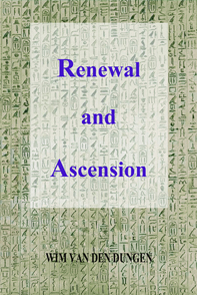On the Shabaka Stone
the most remarkable monument of
Egyptian thought which we possess
general features,
spatial semantics & general contents
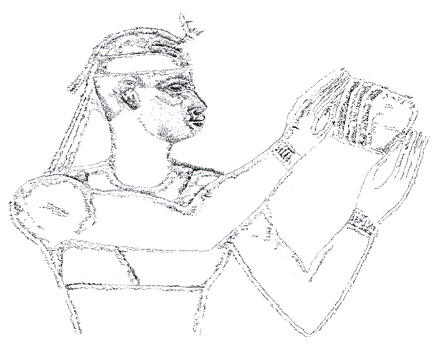
portrait
of Pharaoh Shabaka
from the naos he erected in the temple of Esna
XXVth Dynasty (712 - 698 BCE)
by Wim
van den Dungen
associated papers :
The
Memphis Theology - The Creative Verb in Kemet
TABLE OF CONTENTS
1
General features of the Shabaka Stone.
2
The age of the inscription and its hermeneutical levels.
-
2.1
Extant text, original documents and original ideas.
-
2.2
Worm-eaten documents of the late New Kingdom.
-
2.3 A
new composition of the Late Period.
3 The spirito-political schemes of Pharaoh
Shabaka.
-
3.1
Historical circumstances regarding the kingdom of Kush.
-
3.2
The intent of Pharaoh Shabaka.
-
3.3
Political mystery-play at Memphis.
Bibliography
1
General features of the Shabaka Stone.
1.1 Physical parameters and layout :
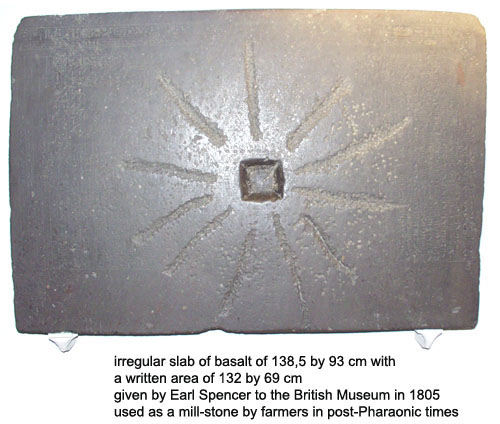
The Shabaka Stone (British
Museum 498) is a heavy, nearly black slab of "Green breccia" from Wadi Hammamat of 137
wide. The left side is ca. 91 cm, the right side ca. 95 cm high. With a density
of 2.7g/cm³, its weight is about 430 kg. It is named after the "black" Pharaoh
Shabaka (ca.712- 698 BCE), who ruled in the XXVth Dynasty (ca. 716 - 702 BCE)
and who's Old Kingdom styled prenomen name ("Neferkare") is mentioned twice (in
LINE 1). It was given by the First Lord of the Admiralty George John 2nd Earl
Spencer (1758 - 1834) to the British Museum in 1805. It was registered in the
inventory of the Museum on the 13th of July of that year. Up to now, its
povenance is still unknown.
For nearly a century, the Shabaka Stone and its inscription remained
unconsidered by egyptologists.
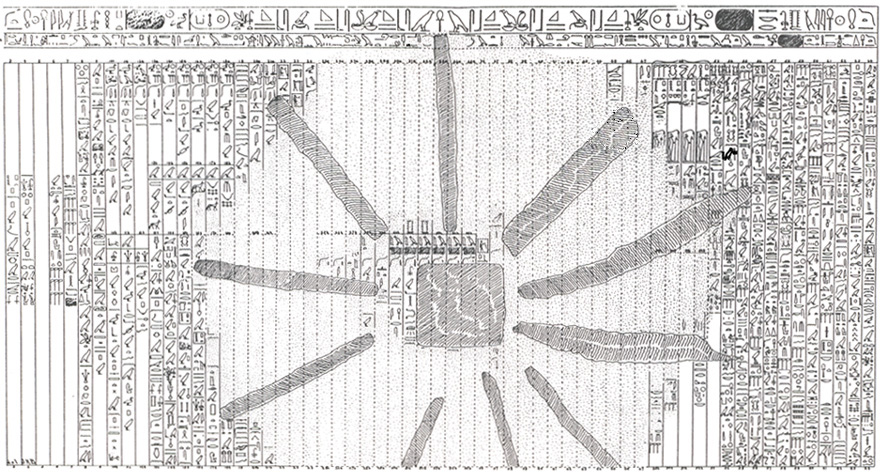
Reconstruction of the layout of the Shabaka Stone
by Breasted (note that he has only 10 channels)
in : Zeitschrift für Ägyptische Sprache und Altertumskunde, Berlin,
n°39 (102), 1902, plates 1 & 2.
For a larger picture :
click here.
Being a stela, it has a written surface of 132 by 68.8 cm, which consists of 3
inscribed horizontal rows (LINES 1, 2 & 48) and 61 columns carved into the obstinate stone with
copper chisels (some columns contain scribal voids, while LINE 5 is empty). A
rectangular squarish hole of 12 cm by 14cm is cut deep
into the stone in the center, out of which eleven rough channels or stripes in
length of 25 to 38 cm radiate as a
result of ignorant disregard in post-Pharaonic Egypt, when it was probably used as a
nether millstone or as a foundation stone. The scribal voids may refer to the damaged original Pharaoh
Shabaka found, namely the outermost edge of a scroll rolled open from left to right
(Sethe, 1928).
This respectless, rejectable
activity has caused a large area of the stone to be worn, with as result the full
or partial erasure of
25
lines (LINES 25 - 44) in the center of the inscription, dividing it in two parts
: one dealing with Horus' justification to his father's throne (first,
left hand side, rendered in a dramatical, responsive way)
and the so-called "theology of Memphis" (last, right hand side, in prose).
Worn areas and scribal voids have to be distinguished.
LINES 3 & 4 are not damaged (except perhaps in the original), but placed by
Shabaka's scribe in an empty area consisting of several columns (cf. infra).
The inscription on the stone is faint thoughout and illegible in the middle.
Spatial
semantics mark the
introduction of the "preface" to this
Memphis
Theology. The latter is followed
by a prozaic "confirmation" of the dramatics of the responsive,
left half. Unfortunately, what united both parts is completely lost.
1.2
Spatial semantics.
Under "spatial semantics" are understood all meaningful visual
& graphic features contained in a text, elucidating the architecture of the
composition, highlighting parts of the text and -on top of what is always the
case in hieroglyphic writing- adding information which is not contained
in the phonography of the text (cf. the determinative in Egyptian), etc.
James Henry Breasted was the first egyptologist to copy the
inscription on the Shabaka Stone by hand, remarking that :
"I have no
doubt that with a better light than it is possible to get in the museum gallery,
more could in places be gotten out."
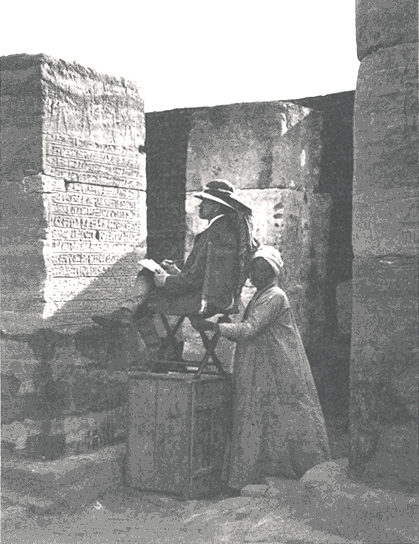
James Henry Breasted
copying a hieroglyphic text in the temple of Buhen, Egypt
(photo taken by Friedrich
Koch in 1906 - The Oriental Institute of Chicago University)
He made this copy for his contribution to the Wörterbuch der
ägyptischen Sprache.
Then, in 1901, he published a brief paper
: "Philosophy of a Memphite Priest" and wrote it was
"the most remarkable monument of Egyptian thought which we
possess." Indeed, for Breasted, the inscription was
"the oldest
known formulation of a philosophical Weltanschauung."
He also discovered the text did not read from right to left
but in "retrograde form". This script is common in religious texts on papyrus.
The order in which the columns had to be read was reversed, even though the
arrangement of individual hieroglyphs remain facing the right.
This and other elements of the special layout of the inscription, compelled
Breasted to date the "worm-eaten" original mentioned in LINE 2 to the early
XVIIIth Dynasty. Breasted's 1901 paper prompted other scholars to study
the extant text. In 1909, Adolf
Erman first put the word "memphitischer" and "Theologie"
together in his "Ein Denkmal memphitischer Theologie". It was Sethe, who
-in 1928- published his "'Denkmal memphitische
Theologie"', der Shabako-Stein", and understood it to be part of
"Dramatische Texte zu altägyptischen Mysterienspielen". The
connotations "dramatic" & "mystery-play" should be given due consideration.
When visiting the British Museum in 2001 (a century after Breasted's first
copy), one of the two lights placed above the stone was found flickering, making
it impossible to copy the text properly. This was switched off by the Curator,
placing the left half of the first two lines in the shadow of the wooden
light-fixture placed above the stone. In 2004, both lights were turned off and
now this shadow covers the complete titulary & colophon. Only by manipulating my
digital pictures, was it possible to eliminate this dark rim. The text provided
by the museum begins with the words : "This text, known as the Shabaqo Stone,
etc ..." ! Breasted complaints are apparently still valid today. This
"most remarkable monument of Egyptian thought which we
possess" is still placed out of focus and neglected (while the Rosetta
Stone is commercially exploited to the point of frenzy - cf. the Rosetta key
ring and the Rosetta mug !).
►
the spatial semantics of the inscription
Certain special spatial features (i.e. a particular use of writable space) deliberately
:
-
create exceptions to the general rule of disposition,
calling for a reversal
of the order in which the columns have to be read (here from left to
right), although the individual hieroglyphs remain facing the right, as in
LINES 1, 2 & 48 and
-
introduce visual units which should be taken into account to
grasp the compositional intent of the inscription, as in certain scribal
voids (LINE 5), dispositions of titles (LINES 3 - 7), responsive, dramatical speech-structures (LINES 10 - 35b) & headings (LINE
48).
Let us turn to the inscription
and study each case separately.
•
LINE 1 (horizontal) is Shabaka's titulary, with its (as usual)
fivefold royal names, except for the surgical erasure of the final, "nomen" name in the
last cartouche ("Shebek", an Egyptianized form of the Nubian
"Shabaka" or "Shabaqo" - "Sebaq-tawy"
probably means : "He who blesses the Two Lands"). Indeed, as such, the name
"Shabaka" can not be found on the stone, although we can read
his prenomen : Neferkare.

Shabaka Stone : LINE : "Neferkare (prenomen), son of Re, (reconstruction of erased nomen name)"
LINE 1 (TITULARY) is larger than any other
line on the stone and written in almost symmetrical (mirror) script,
centered on the hieroglyph "life", and reading out
therefrom, to both left & right.

Shabaka Stone : LINE
1 : "living Horus : excellent Two Lands" - mirror script centered on "life"
"The living
Horus : excellent Two Lands ; the Two Ladies : excellent Two Lands
; the Golden Horus : excellent Two Lands ; King of Upper and Lower Egypt : Neferkare, the
son of Re, [Shabaka], beloved of Ptah-South-of-his-Wall, who
lives like Re forever."
Shabaka Stone, lines 1
(horizontal), titulary.
•
LINE 2 (COLOPHON), the second-largest line, is the story of how Pharaoh
Shabaka found "in the House of his father Ptah"
a worm-eaten ancient
(papyrus ?) text of which he made a new &
better copy, the lasting Shabaka Stone. Here too, the Nubian nomen name or
"Shabaka" has been removed. This line reads from left to right, i.e. in the regular
way, which is an exception here.
"This writing was
copied out anew by his majesty in the House of his father
Ptah-South-of-his-Wall, for his majesty found it to be a work of the
ancestors which was worm-eaten, so that it could not be understood from
the beginning to the end. His majesty copied it anew so that it became
better than it had been before, in order that his name might endure and
his monument last in the House of his father Ptah-South-of-his-Wall
throughout eternity, as a work done by the son of Re [Shabaka] for his
father Ptah-Tenen, so that he might live forever."
Shabaka Stone, line 2
(horizontal), colophon.
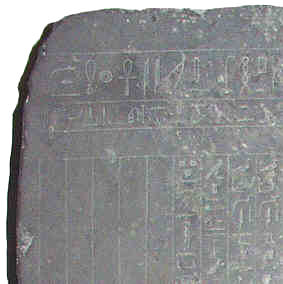
Shabaka Stone : void between the first 2
horizontals & the 61 columns
LINE 1 and 2 are followed by a void
horizontal space, reaffirming the first two lines form a whole, namely
the "general heading".
This consists of the titulary followed by the
colophon. Right at the beginning, the mirror-script used in LINE 1 points to
visual semantics reminiscent of Egyptian art.
The retrograde script of
the columns, starting with LINE 3, contrasts with the colophon, as it were
placing it outside the context of the inscription.
"(3) He is this Ptah who
proclaims by the great name : Tenen. (4) He who united this land of the South as
King of Upper Egypt and this land of the Delta as King of Lower Egypt."
Shabaka Stone, lines 3 & 4
|
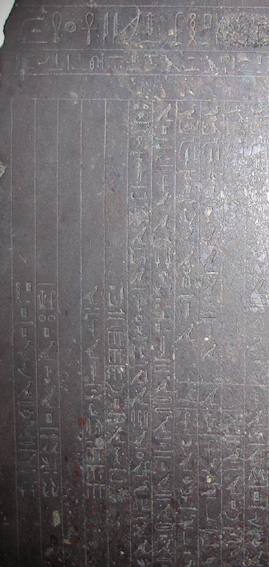
Shabaka Stone : (left) first 5 columns
contain
voids with 5 completely void.
(right) :
detail of the inscribed surface of these lines.
|
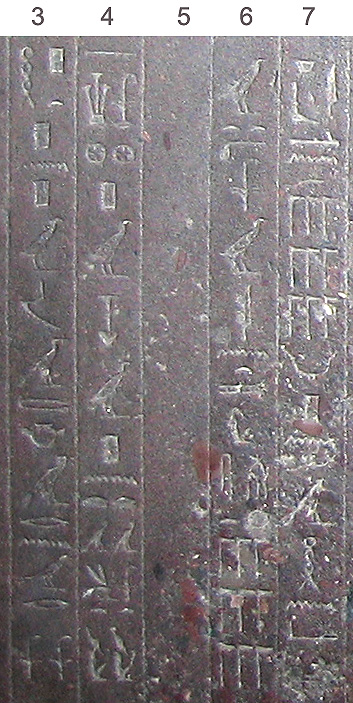
|
"(5) void, no inscription
(6) He indeed begat Atum who gave birth to the Ennead. (7) Geb commanded that the
Ennead gather to him. He judged between Horus
and Seth ..."
Shabaka Stone, lines 5 - 7
The 61 columns have to be read from left to right and from top to bottom. The first five are
only inscribed in the middle, except for column 5. For the rest they are empty above and below
this written area. Column 5 is completely empty. LINE 3 works as a "general preface". Ptah proclaims by his great name of "ta-Tenen", i.e. the
"risen land" of the first moment of creation. The use of
"maT" (proclaim, declare) points to the oratoric nature
of the composition, both as initiatic drama, theology & proto-rational "logos"
philosophy avant la lettre ...
•
LINE 4 confirms the political
power of Ptah. He is the uniter of Upper and Lower Egypt, and so only Ptah is
Pharaoh. Above (celestial, realm of deities) as well as below (terrestrial,
regarding creation, realm of humans) is Ptah's great name in charge.
•
LINE 6 is the "preface"
to the mystery-drama of succession itself. In it, other deities will be invoked. Hence, the
author makes sure to mention Ptah is the father of Atum, the creator-god of
myth and pre-rationality, who created himself and all the rest. Hence, Ptah is before
Atum. This idea of firstness is repeated in LINE 48, the heading of the lines
introducing the theology of Memphis & the political unity of the royal
Residence. However, because
Ptah begat the Heliopolitan creator-god Atum, his name is greater than
Atum's, although the latter gave birth to the Ennead, i.e. to all gods &
goddesses. Hence, Ptah's all-encompassing nature is put into evidence.
The
supremacy of Ptah over Atum is the core of this theology.
Hence, LINES 3 - 6 contain the summary of Ptah's claims to suprimacy over the
eternal and temporal orders of being.
• LINE 7 : here the actual political
mystery-drama starts.
Lines 10 to 35 are responsive. When the gods are
speaking to each other, their hieroglyphs face each other, suggestive of
Egyptian pictoral composition. This spatial syntax is also reminiscent of
ritual "rubrics" and the stage-work of mystery-plays & sacred
festivals. Unfortunately, these lines are very worn and so the complete drama is lost.
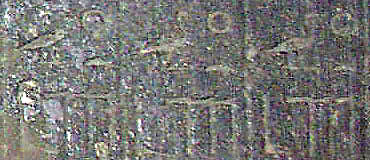
Shabaka Stone : LINES
15a - 17a : "Geb's words to the nine gods :"
Notice how the flagpoles are reversed, pointing to the Geb-goose, as in direct
speech.
"(10a) Geb's words to Seth : "Go to the place in which you were
born."
(10b) Seth : Upper Egypt.
(11a) Geb's words to Horus : "Go to the place in which your father was
drowned."
(11b) Horus : Lower Egypt.
(12a) Geb's words to Horus and Seth : "I have separated you."
(12b) Lower and Upper Egypt.
(10c, 11c, 12c) Then it seemed wrong to Geb that the portion of Horus was like the portion
of Seth. So Geb gave Horus his inheritance, for he is the son of his firstborn
son.
(13a) Geb's words to the Ennead : "I have appointed
(13b) Horus, the firstborn."
(14a) Geb's words to the Ennead : "Him alone,
(14b) Horus, the inheritance."
(15a) Geb's words to the Ennead : "To his heir,
(15b) Horus, my inheritance."
(16a) Geb's words to the Ennead : "To the son of my son,
(16b) Horus, the Jackal of Upper Egypt ---
(17a) Geb's words to the Ennead : "The firstborn,
(17b) Horus, the Opener-of-the-ways."
(18a) Geb's words to the Ennead : "The son who was born ---
(18b) Horus, on the birthday of the Opener-of-the-ways."
>
(13c) Then Horus stood over the land. He is the uniter of this land, proclaimed
in the great name : Tenen, South-of-his-Wall, Lord of Eternity. Then sprouted
(14c) the two Great in Magic upon his head. He is Horus who arose
as King of Upper and Lower Egypt, who united the Two Lands in the Nome of the
(White) Wall, the place in which the Two Lands were united.
(15c) Reed (heraldic plant for Upper Egypt) and papyrus
(heraldic plant for Lower Egypt) were placed on the double door of the House
of Ptah. That means : Horus and Seth, pacified and united. They fraternized so as
to cease quarreling
(16c) wherever they may be, being united in the House of Ptah, the
"Balance of the Two Lands" in which Upper and Lower Egypt had been
weighed. This is the land
>
(17c) --- the burial of Horus in the House of Sokar.
(18c) --- Isis and Nephthys without delay,
(19) for Horus had drowned in his water. Isis [and Nephthys] looked out.
(20a) Horus speaks to Isis and Nephthys : "Hurry, grasp him
---."
(21a) Isis and Nephthys speak to Horus : "We come, we take you ---."
(20b) --- and brought him to
(21b) --- the earth
(22) at the royal fortress, to the North of ---.
(23) There was built the royal fortress ---.
(24a) Geb speaks to Tehuti : ---
(25ab - 30a) ---
(31a - 35a) ---
(27b) [Geb] speaks to Isis : ---
(28b) Isis causes [Horus and Seth] to come.
(29b) Isis speaks to Horus and Seth : "---."
(30b) Isis speaks to Horus and Seth : "Make peace ---."
(31b) Isis speaks to Horus and Seth : "Life will be pleasant for you when
---."
(32b) Isis speaks to Horus and Seth : "It is he who dries your tears
---."
(33b - 35b) Isis speaks to ---.
(36 - 47) ---"
Shabaka Stone : line 10a - 49 : the
dramatical mystery-play
Whether this mystery-play stopped before LINE 48 is unknown (it certainly runs to
LINE 35b). So it is possible there were of few lines joining the two major parts of the inscription (LINES 36 -
47), but this is in no way certain.


Shabaka Stone : LINE 48 :
"the gods who manifest in Ptah"
retrograde and horizontal (left to right)
•
LINE 48 has a unique spatial disposition : retrograde and horizontal.
It is intended as the heading for the text below, which introduces the
epiphanies of Ptah, i.e. his Ennead.
The position of LINE 48 indicates the text which follows is of a different nature than the dramatical,
responsive justification of the throne of Horus. The unique spatial disposition
of LINE 48 coordinates this brief horizontal with the vertical texts
directly beneath it. This because it is the heading for the inscription
below, introducing the theology of Ptah of Memphis.
|
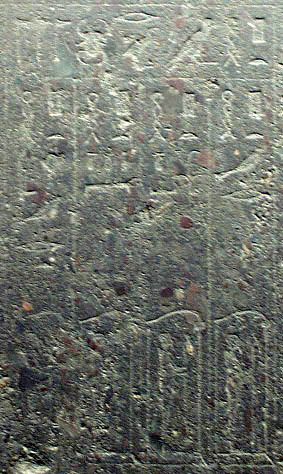
Shabaka Stone :
LINES
48-52
- notice mummiform Ptah with skull cap & was-scepter standing in
a shrine.
|
The inscriptions in LINES
49a - 52a
are each followed by a special determinative showing the iconographic
form of Ptah standing in a shrine. Underneath, In LINES 49b - 52b further specifications follow :
"(48) The gods who manifest in Ptah :
(49a) Ptah-on-the-Great-Throne, ---
(49b) [Ptah] --- who bore the gods.
(50a) Ptah-Nun, the father who gave birth to Atum.
(50b) [Ptah] --- who bore the gods.
(51a) Ptah-Naunet, the mother who bore Atum ;
(51b) [Ptah] ---
(52a) Ptah-the-Great, heart and tongue of the Ennead ;
(52b) [Ptah] --- Nefer-Tem at the nose of Re every day." |
After the divine speech of the deities in the dramatical section (LINES 7
- 35b), LINES 48 - 52 reiterate the unique nature of Ptah, who created all
(cf. LINE 6). In this way, the divine comedy is flanked on two sides by
the articulation of divine unity. Furthermore, by placing Ptah in a
shrine, Shabaka's scribe no doubt wanted to direct the reader's attention to
what followed, namely the "core" of the inscription, the theology of
Ptah of Memphis. Good fortune has kept it intact despite the ignorance of
those who used the stone for its shape and weight !
In LINE 53, "Ptah-the-Great" is invoked. The greatness of Ptah and the
superiority of his theology is directly related to the "heart and tongue of
the Ennead" (LINE 52a) and the whole theology of Memphis is a justification
of Ptah's exclusiveness (the "very great") on the basis of an original
redefinition of the concepts "heart" & "thought",
thereby articulating the earliest known (proto-rational)
"logos"-philosophy. Although gods & goddesses are mentioned, it is
stressed they came into being "in" Ptah, in his heart and by his tongue.
After Ptah's epiphanies (LINES 48 - 52), the "Memphis Theology" (LINES
53 - 61) follows. Both LINES 53 & 54 are introduced using parallel script, whereby a doubling
occurs and two lines are pressed into one. The
end of LINE 53 contains a large scribal void, showing the intent was to
place two of these parallel inscriptions next to each other. For only in
this configuration is the central verb "to come into being" (the
scarab) repeated four times in a row, aligning this hieroglyph with the same verb in LINE
48, were
Ptah's creation of the gods is mentioned (in the Pyramid Texts, four repetitions
point to the four quaters of the horizon).
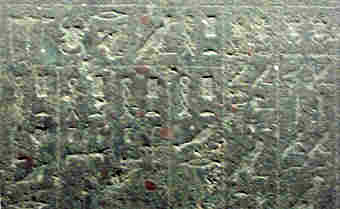
Shabaka Stone : line
48-54 : notice how last two colums are doubled
LINES
53 - 61 are studied in a paper on the
Memphis Theology.
"(53) There comes into being in
the heart ; there comes into being by the tongue as the image of Atum ! Ptah is the very great, who
gives life to all the gods
and their kas. Lo, through this heart and by this tongue.
(54) Horus came into being in
him ; Thoth came into being in him as Ptah. Life power came into being in the heart and
by the tongue and in all limbs,
in accordance with the teaching that it (the heart) is in all bodies and
it (the tongue) is in every mouth of all gods,
all men, all flocks, all creeping things and whatever lives ; thinking
whatever the heart wishes and commanding whatever the tongue wishes !
(55) His (Ptah's) Ennead is before him as
heart, authoritative utterance, teeth, semen, lips and hands of Atum. This Ennead
of Atum came into being through his semen and through his
fingers. Surely, this Ennead (of Ptah) is the teeth and the lips in the mouth,
proclaiming the names of all things, from which Shu and Tefnut came
forth as him, and
(56) which
gave birth to the Ennead (of Ptah).
The sight of the eyes, the hearing of the ears, and the breathing of air
through the nose, they transmit to the heart, which brings forth every decision.
Indeed, the tongue thence repeats what is in front of the heart. Thus
was given birth to all the gods. His (Ptah's) Ennead was completed.
Lo, every word of the god came into being through the thoughts in
(57) the heart & the command by the tongue. Thus all witnessing faculties were
made and all qualities determined, they that make all foods and all provisions,
through this word. {Justice} is done to him who does what is loved, {and
punishment} to him who does what is hated. Thus life is given to the peaceful
and death is given to the criminal. Thus were made all labor, all crafts, the
action of the arms, the motion of the legs,
(58) the movements of all the limbs, according to this word which is devised by
the heart and comes forth by the tongue and creates the performance of
everything.
>
There came the saying that Atum, who created the gods, said concerning Ptah-Tenen : "He gave birth to the gods." From him every thing came forth :
foods, provisions,
(59) divine offerings, all good things. Thus Thoth knew and recorded that he is the mightiest of the gods. Thus Ptah was satisfied after he had made all things and all
divine words.
He gave birth to the gods, he made the towns, he established the nomes, he
placed the gods in their
(60) shrines, he settled their offerings, he established their shrines, he made
their bodies according to their wishes. Thus the gods entered into their bodies
of every kind of wood, of every kind of stone, of every kind of clay, in every
kind of thing that grows upon him (61) in which they came to be. Thus all the gods and their kas were gathered to
him, content and united with the Lord of the Two Lands.
>
The Great Throne (Memphis) that gives joy to the heart of the gods in the House
of Ptah is the granary of Tenen, the mistress of all life, through which the
sustenance of the Two Lands is provided,
(62) owing to the fact that Horus was drowned in his water. Isis and
Nephthys looked out, beheld him, and attended to him. Horus quickly
commanded Isis and Nephthys to grasp Horus and prevent his drowning.
(63) They heeded in time and brought him to land. He entered the secret
portals in the glory of the Lords of Eternity, in the steps of him who
rises in the horizon, on the ways of Re at the Great Throne.
(64) He entered the palace and joined the gods of Tenen Ptah, Lord of Years.
Thus Horus came into the earth at the Royal Fortress, to the North of this land to which
he had come. His son Horus arose as King of Upper Egypt, arose as King of
Lower Egypt, in the embrace of his father Horus and of the gods in front of
him and
behind him."
Shabaka Stone : line 53-64 : the
theology of Memphis (53 - 61) and the royal residence (61 - 64)
1.3
Contents of the inscription on the Shabaka Stone.
The table of contents of the inscription has 6 sections :
-
LINES 1 - 2 : heading
(titulary, colophon) : general information about the stela & editorial
remarks concerning its composition ;
-
LINES 3 - 6 : prefaces : LINES 3 - 4
: general declaration of Ptah's supremacy as
proclaimer of the great name of "Tenen" and as Pharaoh and LINE 6
: introduction of the mystery-drama of the deities created by Atum who is
begat by Ptah ;
-
LINES 7 - 35b : the
mystery-drama : here the division (decided by Geb) of the rule of Egypt
between Horus and Seth is narrated and enacted. This settlement is
replaced by the union of the Two Lands under the sole rule of Horus, who
is a manifestation of Ptah.
-
LINES 48 - 52 : new heading
& Ptah's epiphanies : reaffirmation that all deities are
manifestations in Ptah, to whom Ptah gave birth ;
-
LINES 53 - 61 : the
theology of Memphis ;
-
LINES 61 - 64 : the royal
residence : Memphis is the city of Ptah-Tenen.
Section V, the theology of
Memphis, has three subdivisions :
-
LINES 53 - 57 : logoism :
the description of the logoic process with which Ptah created everything,
including all possible deities and the reason why this Memphite theology
supercedes the Heliopolitan one of Atum. Rudiments of an epistemology
are given ;
-
LINES 57 - 58 : natural
philosophy : and a holistic philosophy of
nature ;
-
LINES 58 - 61 :
pan-en-theism : poetical affirmation that Ptah is everywhere &
everything and that all is in Ptah. Ptah is above (celestial) as well as
below (terrestrial).
2 The age of the inscription and its hermeneutical levels.
2.1
Extant text, original documents and original idea.
Breasted concluded the original text used to compose the Shabaka inscription was
probably written in the XVIIIth Dynasty (ca. 1539 - 1292 BCE), i.e. at the beginning
of the New Kingdom. The
work of later investigators (Erman, Sethe, Junker, Frankfort) abandoned
Breasted's justified caution and carelessly dated the original text between the Ith and the Vth
Dynasty (ca.3000 - ca.2348 BCE) ! Even Frankfort
claimed :
"The Memphite Theology presents the religious
teaching for Menes' new capital. It combines views which we can recognize as
new, since they concern the new foundation ; others which we suspect to be new
because they run counter to common Egyptian beliefs and could hardly have gained
acceptance it they had not been part of the great movement at the dawn of
history. Other doctrines again seem to be rooted in Egyptian, or even African,
traditions of the greatest antiquity."
Frankfort, 1978, p.24.
At present, Grimal is the
only egyptologist who continues to propose Old Kingdom dates for the lost
original mentioned in LINE 2.
"Ce texte date manifestement de l'Ancient
Empire, période où Memphis joua le premier rôle national, et sans doute même
de la Ve dynastie, c'est-à-dire de l'époque où la doctrine héliopolitaine
l'a définitivement emporté." -
Grimal, 1988, p.57, my italics.
However, for Friedrich
Junge (1973), there are
no philological grounds to
ascribe the text to the Old Kingdom. As Breasted, he returned to the New Kingdom
to find the source(s) used by Shabaka's scribe. He thinks an original compendium of texts was
transformed in a free and adaptive way, shaping a new and more complex
configuration. The original compendium
might date back as far as the Ramesside period, the late New Kingdom, a period
of intensive religious speculation (XXth Dynasty - ca. 1188 - 1075 BCE - cf. the
Hymns to Amun). Indeed, after
Amarna (ca. 1336 BCE), Ptah & Memphis were
important again. Hornung (1989) also rejects
an Old Kingdom date for the original text and accepts a late New Kingdom date.
These considerations lead me to propose the following historical path :
-
extant text :
ca. 710 BCE (XXVth Dynasty) - end of the Third Intermediate Period ;
-
original text :
ca. 1188 - 1075 BCE (XXth Dynasty) - late New Kingdom ;
-
... lost texts ... other texts
... sapiental literature and Coffin Texts of Middle Kingdom ...
-
original
idea : "Sia" & "Hu" in the Pyramid Texts or
(late Vth & VIth Dynasties (ca.2378 - 2205) - Old Kingdom (see my
The
Creative Verb in Kemet).
2.2
Worm-eaten documents of the late New Kingdom.
If the original, worm-eaten compendium found by Pharaoh Shabaka was written in the
late New Kingdom (which is very likely), and the hermeneutical form of these
New Kingdom originals was canonical, i.e. defining a well-defined cultural identity or symbolic form
(concerning Ptah of Memphis), implying these documents were the culmination of the evolutionary process of
the form of the thoughts in question and not just the whimsical invention of the Memphite
theologians of the New Kingdom, then clearly the origin of these ideas
(perhaps not
documented as such) could
bring us back to earlier periods.
The proposed original
text could then be regarded as a summary or canon of an older tradition, with
an even more remote historical origin, going back to the moment when these ideas
actually emerged for the first time (likely in much cruder and less
coherent forms).
Why not as far back as the Old Kingdom,
when -although the Heliopolitan view predominated- the role of Ptah of
Memphis is attested ? He was the guardian of the union of the Two Lands (cf.
Menes). At Memphis, Pharaoh was enthroned, and so the "Walls" was the
dynastic city par excellence. Through his Great Word, Pharaoh
established Maat. His tongue was the pilot in charge of the bark of
righteousness and truth.
Given the important theological crisis at hand
after
Amenhotep IV (Akhenaton), namely the restoration of the "true
religion" and the (incomplete) destruction of the rejected influence of the
culture of Amarna and the theology of
Akhenaten, a return to Ptah of Memphis
could be argued as inevitable and rewarding to seal the completion of the
restoration. The all-comprehensive nature of Ptah's creative thoughts is also
suggestive of the New Solar Theology and the conceptual revolutions brought
about by Amarna theology (like the rejection of the plural for the word
"god"). Hence, as was also the case in art, all traces of the changes Amarna had brought, were
not eradicated. Moreover, does the strong "political" message of the
original text not point to the restored post-Amarna context (for
example early XIXth Dynasty under Seti I or Ramesses II) ?
Even during the
wildest days of Akhenaten, not all ancient cults had stopped and nobody knows how
many gods & goddesses had been worshipped in secret.
After the death of Akhenaten, the capital remained only two
years in al-Amarna before it moved (under Tutankhamun) to Memphis. In the period
of restoration which followed his reign, the main goal was to maintain the unity
of the Two Lands by allowing Pharaoh to make strong political statements of
monumental proportions (cf. Seti I, Ramesses II). The choice of Ptah can thus
also be attributed to the theo-political
importance of Memphis as the place of coronation of the living god on Earth, who again properly
invited the deities who
had left Egypt and who headed the temple cults of the old pantheon.
In the
Ramesside period, the thirteenth son of Ramesses II, Merneptah, erected an
important palace complex near the temple of Ptah and the old capital city
of Memphis rose to renewed splendor with his aid. Was the original text of
the inscription on the Shabaka Stone written under his reign (ca. 1210 BCE) ?
It is likely the alleged New Kingdom authors who wrote the original
text (the text found by Pharaoh Shabaka) used lost originals, i.e. older sources.
We know both major themes of the inscription (the unity of the Two Lands
and the creation of the Ennead and the world through "divine words") are present in the literature of
the Old and Middle Kingdoms (cf.
The Creative Verb in Kemet). Perhaps our New Kingdom scribes found or were given
access to libraries, worm-eaten documents or bits and pieces of the former cults of Ptah at Memphis. With this
in hand, they wrote their XIXth Dynasty original, worm-eaten by the time of
Pharaoh Shabaka (ca. 6 centuries later). They too were confronted with an older
language and had to rework the material to honor the cult of Ptah (as did
Shabaka's scribe after them).
2.3 A new composition of the Late Period.
The egyptologists of the British Museum rightly assume the Shabaka inscription
itself is a
compilation, reproducing the layout of earlier documents and
introducing a number of archaisms
(older spellings
&
grammatical usages) to lend the piece an air of antiquity. That
Shabaka's scribe succeeded, may explain why it took egyptologists so
long to correctly date the original text mentioned in the colophon. Junge
points out Shabaka's claim may well be true in a literal sense, i.e.
Shabaka's rescue made the text indeed "better than it had been
before", because he had arrived at a superior, more complex and
advanced conceptual configuration than what had been available to him in
the original, worm-eaten documents.
Let us conclude the inscription on the Shabaka Stone is a
XXVth dynasty (early 8th century BCE) canon of the spirito-political unity
represented by Ptah. Shabaka does not forget to mention he made use of
earlier canonical compendia, allowing him to stay "in line" with the
traditional tenets of the canon. His stone will eternalize the great mystery
of Ptah. But the language must sound old, so that the Nubian may win the favor
of the spirits of old ...
3 The spirito-political schemes of
Pharaoh Shabaka.
3.1 Historical
circumstances regarding the kingdom of Kush.
The Kushite Pharaohs from Nubia constitute the "XXVth Dynasty", also
called "Napatan", from the city of Napata near the 4th cataract of the
Nile (one of the Kushite kingdom's principal cities). For the Israelite prophet
Isaiah, it was "a land shadowing with wings beyond the rivers of
Kush", for the Assyrians, Kush was a "far and inapproachable
region". The southern limits of Kush were regarded by the Egyptians
themselves as the "horn of the earth" (i.e. the outer limits).
"This image of a remote and exotic
land, the source of ivory, gold, incense and slaves, was perpetuated through
Greek and Roman literature into the writing of modern Egyptology." -
Morkot, 2000, p.1.
The conquest of Egypt by the Kushite kings in the 8th century BCE was portrayed
as an unexpected event (cf. the Victory Stela of Piye), with no prologue.
However, the tradition of rulership in Nubia extends back as far as two thousand
years before the emergence of the Napatan state. This continued under Egyptian
rule and was influenced by the Egyptian style of kingship. To understand the
period the Kushites dominate Egypt, we must look back at the development of
states and rulerships within Nubia, from Predynastic Egypt up to the 8th century.
Let us trace these important steps.
► Nubia in Egypt's Predynastic times :
The southern boundary of the Predynastic kingdom of Nekhen (Hierakonpolis) was
Gebel Silsila, the narrowest point on the Nile and the northern limit of Nubia.
Its main trading centre was probably the island of Abu (Elephantine), at the
foot of the 1th cataract, reflecting the importance of ivory as one of the more
important southern commodities (along with ebony, incense, vegetable oils &
animal skins). Wine, beer, oil and perhaps wheat and barley were also exchanged
for the valuable raw materials. Rock-drawings of boats of Predynastic type have
been found as far South as Sabu at the 2th cataract. The rapid development of
strong states around 3100 BCE was not confined to (Upper) Egypt. Rather, there
existed a mutual influence.
► Nubia at the start of the Pharaonic age :
Climatic changes and variations in the flood levels alone do not explain how the
people of Nubia and its powerful kingdoms came to their end. The depopulation of
Lower Nubia during the period of the Old Kingdom went hand in hand with the rise
of the Pharaonic state. The Egyptian Pharoah was no longer content to exchange
goods but desired to gain control of the Nile route to the South, exploiting
Nubia's natural resources directly. Ruthless interventions through military
actions crushed the local powers, realized by the reign of Djer (early Ith
Dynasty). The surviving Nubians were driven into the regions flanking the Nubian
Nile valley (possible the more fertile eastern hills & wadis). The Egyptians
exploited Nubia's resources. The largest settlement in Nubia was at Buhen, at
the foot of the 2th cataract (founded early IIth Dynasty). Djedkara-Isesi is the
last Old Kingdom Pharaoh attested in Nubia. These kings relied on Egyptian
rather than local labour.
► Nubia at the end of the Old Kingdom :
In the later Old Kingdom, the climate deteriorated throughout North-East Africa,
resulting in the VIth Dynasty in conditions similar to those of the present-day.
Rhinoceros, elephant and giraffe which had existed much earlier in Egypt and
Lower Nubia had dissapeared and could only be found in Upper Nubia and further
South. A new culture emerged in Nubia. This "C-group" is in many ways
so similar to that of the Nubians of the A-group (of Egypt's Predynastic times)
that scholars agree its people descended from it. By the VIth Dynasty,
Pharaoh did no longer control Lower Nubia. To acquire goods from the South, he
had to negotiate with Nubian rulers again. Hence, the Old Kingdom Pharaoh's had
not been able to eradicate the Nubians.
► Nubia in the First Intermediate Period :
At the end of the reign of Pharaoh Pepi II, the local elites of Egypt (the
"nomarchs" or local officials of the districts, the "nomes")
gained more power. In the decades following his death, a breakdown of
centralized government ensued. There had already been famines in the Vth
Dynasty, and this problem recurred. At first, the local officials acknowledged
the Memphite kings as the source of legitimate divine & political power.
Then, they arrogated many of the royal epithets. Eventually, they forgot about
their allegiance to Memphis and assumed royal titles. Two major nomes emerged :
"Nen-nesut" (Herakleopolis), south of Memphis and "Waset"
(Thebes), in Upper Egypt.
Lower & Upper Nubia were affected by these changes. Trade was disrupted but
did not cease. Local armies included contingents from Nubia. With the
expansion of Theban power, interaction with Nubia became inevitable. Nubian
mercenaries lived and worked in Upper Egypt, and these soldiers had Egyptian
servants, suggestive of their high status. Texts record how the Theban rulers
lead their armies into the northern part of Nubia.
►
Nubia in the Middle Kingdom :
When Pharaoh Nebhepetre Menthuhotep II reunited Egypt (ca. 2040 BCE), a new period of
stability was inaugurated. The prominence of Nubian militia in Upper Egypt
during the ascendancy of the Theban princes may have lead to marriage alliances
between, on the one hand, the ruling families of Nubia and the Eastern desert,
and, on the other hand, Theban rulers. Some have speculated that the four
consorts of Menthuhotep II were of Kushite origin, if not Pharaoh himself. In
the Prophecies of Neferti, we read : "Ameny, the justified, by name,
son of a woman of 'Ta-Seti', a child of Upper Egypt." "Ta-Seti"
or "Bow-Land" was the name for the 1th nome of Upper Egypt (from
Elephantine to Edfu) as well as for Nubia. Pharaoh
Amenemhat I,
who was assassinated, may have had some Kushite
blood.
By the time of the latter's coronation, Nubia had regained its independence and
was ruled by local kings who adopted the style of Pharaohs ... However, by the
time of the XIIth Dynasty expansion, the united kingdom of Lower Nubia was a
formidable obstacle. Intense Egyptian military activity ensued. After a series
of major campaigns (taking a full century), Nubia was subdued. But, once the
trade routes had been secured, no attempt was made to integrate the Nubians
of the "C-group". The Egyptians built a number of forts to
protect access to gold-mining regions (cf. the Middle Kingdom fortress of Buhen,
well under way by year 5 of Senwosret I - ca. 1923 BCE). The Lower Nubian kings
posed no threat and payed their "inu"-tribute, evidence of an alliance
with Pharaoh.
In Upper Nubia, the kingdom of Kerma (on the East bank, South of the 3th
cataract) flourished (Kush was based upon Kerma). The rulers of Kerma acted as
the main intermediaries for the transmission of goods from the south to Egypt.
Initially, Kerma-culture (which seem to develop about the time of the First
Intermediate Period) was supported by the Egyptians of the Middle Kingdom. Its
power climaxed in the late Second Intermediate Period. The kingdom was
court-based and wealthy.
► Nubia in the Second Intermediate Period :
At the beginning of the XIIIth Dynasty, Egypt withdrew from Nubia and entered a
period of great confusion. Kush (founded on Kerma) becomes the most important
state in Nubia. The Kushite expansion into Lower Nubia & beyond begins. They
managed to penetrate the outer defences of Buhen and capture & burn the
inner fort. Extensive destruction followed. In Lower Nubia, C-group culture
continued to flourish. It reached its peak although under the political rule of
the Kushite kings. Those in command gave the Kushite kings access to both the
desert roads and the river route to Upper Egypt. They traded directly with the
new rulers of the Delta, the Hyksos kings of Avaris (Lower Egypt). The presence
of Egyptians at Buhen and other forts points to a considerable egyptianization
of Kerma culture.
The Theban princes, trapped between the Hyksos and the Kushite -who seek
alliances against Thebes- move to reunite Egypt under their own rule. Kamose
(Wadjkheperre), with whom the Second Intermediate Period ends (ca. 1539 BCE),
regained control over the 2th cataract and reoccupied the fortress at Buhen. His
brother Pharaoh Ahmose (Nebpehtire, ca.1539 - 1514 BCE) was victorious against both the
Hyksos and the Kushites and initiates the XVIIIth Dynasty and with it the
"imperial age" of Egypt.
►
Nubia in the New Kingdom :
While engaged with the Hyksos, Buhen had been under attack by the Kushites. For
the Egyptians, the Kushite kingdom thus remained a threat. In regnal year 2,
Pharaoh Tuthmosis I (Akheperkare - ca.1493 - 1482 BCE) inflicted a major defeat on the
Kushite state, with the attack of Kerma itself. The city recovered quickly. The
Egyptians withdrew and established their southern border at the 2th cataract
(Lower Nubia had been incorporated into Egypt). The resistance was however not
broken and conflicts in Lower Nubia were more than likely. Pharaoh Tuthmosis III
(Menkheperre - ca. 1479 - 1426 BCE) made the Kushites finally bow to the Egyptian
rule. Pharaoh drew the official border at the 4th cataract, erected the fortress
of Napata called "Semakhasetiu" or "Hacking up the Foreign
Lands" and named the mountain Gebel Barkal : "Throne of the Two
Lands". But Egypt's influence stretched much farther. Indeed, Pharoah had
reached the land of Miu (central Sudan) where the rhinoceros was captured. Tax
& tribute of Upper Nubia flowed into Pharaoh's treasury.
In the reign of Pharaohs Amenhotep II or Tuthmosis IV, 150 years after Egyptian rule in
Nubia, the administration of the whole region was reorganized along Egyptian
lines : the Viceregal system. Two provinces were created : "Wawat"
(Lower Nubia) and "Kush" (Upper Nubia). A Viceroy ruled Nubia as a
whole (from Nekhen to the 4th cataract). Each province came under the control of
an official directly responsible to the Viceroy (just as the Viziers were
subordinate to Pharaoh). In return of the goods of the South, these officials
would receive Egyptian foodstuffs, cloth, manifactured objects, military and
political support. As there are no records of trading expeditions, we may assume
that the provincial governors were Kushites. Once absorbed into the Egyptian
system, the Kushites were depicted as Egyptians. The education of Kushite
princes at the Egyptian courts assisted the assimilation of Kushite culture into
the Egyptian imperial civilization of the New Kingdom.
Ambassadors of Lybia (stretching along the Meditarranean littoral as far as
Cyrenaica) visited the court of Akhenaten. But with the reign of Pharaoh Horemhab
(ca.1319 - 1292 BCE), the Libyans are recorded as enemies of Egypt. They invaded
the Delta on a massive scale. Libyans and Kushites are said to have planned an
unsuccesful joint attack on Egypt. Ramesses III (ca. 1186 - 1155 BCE) was the
last Pharaoh able to counter the Libyan invasions.
► Nubia in the Third Intermediate Period :
At the end of the New Kingdom (ca. 1075 BCE), the power of Pharaoh had
weakened. In the period which followed, the Third Intermediate Period, Nubia and
the eastern desert were lost again (as well as the "Asiatic" regions).
The title "Viceroy of Kush" becomes extinct. With Pharaoh Shoshenq I (945- 924
BCE) the Lybian tribal chieftains of the Delta rise to the throne of Egypt. By that time, they
too had been assimilating Egyptian culture & customs for several
generations, and seemed not essentially different, although Thebes hesitated. By
the time of the Kushite invasions, there were four Pharaohs ruling in different
parts of Egypt.
In the middle of the 8th century BCE, a new political power appeared in the
extreme South. It had for some generations been building up an important kingdom from
their center at Napata at the 4th cataract. They felt to be Egyptians in culture
and religion (Amun). The first king of this Kushite kingdom was Kashta. With
Piye (740 - 713 BCE), probably his eldest son, we draw nearer to Pharaoh
Shabaka.
► the enigmatic Piye
Piye himself was crowned in the temple of Amun at Gebel Barkal, as "Horus,
Mighty Bull, arising in Napata". He went to Thebes to be acknowledged
there. After having consolidated his position in Upper Egypt, Piye returned to
Napata (cf. "Victory Stela" at Gebel Barkal). In Lower Egypt, a future
opponent, Tefnakht ruled the western Delta, with as capital Sais (city of the
goddess Neith, one of the patrons of kingship). Near Sais were also the cities of
Pe and Dep (Buto), of importance in the earliest periods of Egyptian history,
and cult centre of the serpent goddess Wadjet, the uræus protecting Pharaoh's
forehead (the raging Eye transformed and symbol of Pharaoh's assimilation of the Great Goddess of the
sacred of predynastic times - cf.
To Become a Magician).
When the rulers of Thebes asked for help, Piye's armies moved northwards. When
he sent messengers ahead to Memphis with offers of peace, they closed the gates
for him and sent out an army against him. But with no avail. Piye returned
victoriously to Napata and never went to Egypt again.
3.2 The intent of Pharaoh Shabaka.
► the restoration of the power of the Memphite Residence
Pharaoh
Shabaka, this
black African "Ethiopian", was the first Kushite
king to reunite Egypt by defeating the
monarchy of Sais and establishing himself in Egypt. Piye before him
had defeated the Egyptian dynasts, but had victoriously returned to Napata.
Shabaka, who figures in Graeco-Roman sources as a semi-legendary figure, settled
the renewed conflicts between Kush and Sais and was Pharaoh in Egypt,
with his Residence and new seat of government in Memphis
(cf. Frankfort on the importance of Memphis). Indeed, Pharaoh Shabaka modelled
his reign upon the Old Kingdom Pharaohs.
► Memphis : the city of the coronation of the Pharaohs
"Men-nefer" or "Memphis" was the capital of the first
nome of Lower Egypt. It was called "horizon of the Two Lands",
"city of walls", "the balance of the Two Lands". In the city
or its neighbourhood were the temples of Ptah, Sekhet, Bast, Hathor, Osiris,
Seker and of course Re. The temple of Ptah was on the eastern side. In the Old
Kingdom, Memphis was the place were Pharaoh was coronated in the definitive
ceremony of succession. Pharaoh Shabaka residing at Memphis was the political proof
Egypt had been reunited.
►propagating the consolidation
of Kushite rule in Egypt
The
Shabaka Stone, with its Pyramid Texts styled language &
archaism, was
originally set up in the temple of Ptah at Memphis, to which both Piye and
Shabaka had added structures.
It is clear this stone had to
prove the legitimacy of the power of the Nubians and the Nubio-Sudanese
Kushite Dynasty
(Egypt and the whole of Nubia unified). The Shabaka Stone proved Pharaoh
of Memphis was again the sole
ruler uniting the "Two Lands" ... Shabaka consolidated Kushite
supremacy and his reign saw the first major building works of the Kushites in
Egypt. In the Theban region the temple of "Ptah-South-of-his-Wall" was
enlarged. The shrine of Amun at Thebes and Hathor at Dendera proved his concern
for the temples throughout Egypt. His constructions at Thebes are best
preserved.
However, the "Ethiopian" Dynasty did not stop the further decay of Egyptian
autonomy and unity. Thebes was sacked under the Assyrian occupation (671 - 664
BCE) and although Psammetikus I (Wahibre) expelled the Assyrians, Psammetikus
III (Ankhkaenre) was kept in power by the Persians but commited suicide (end of
the XXVIth "Saite" Dynasty, marked by a resurgence of the arts, based on the
classical forms of the Old and Middle Kingdom).
3.3 Political mystery-play
at Memphis.
On the large roll of papyrus, discussed in the second
part of Sethe's Dramatische Texte, is found the accession script of the
"mystery play of the succession" (Frankfort) of Pharaoh Senwosret I (Middle
Kingdom), probably containing elements antedating the Middle Kingdom. It seems this play was performed during the transition after the death of Pharaoh's
predecessor but before his coronation at Memphis and this seemingly in several
cities throughout the land (the god receiving the offerings is indicated by a
generic term only).
It was necessary of Pharaoh to pass through these repeated ceremonies at the
various cities to establish the necessary politico-religious ties to his
"Great Throne" at Memphis (compare this with his circumambulations
of the "Heb-Sed" court during the Sed-festival). During the mystery
play, Pharaoh remained on board of the royal barge, serving as his quarters
during travel.
In the mystery-drama on the Shabaka Stone, the succession-drama is intra-divine,
for Ptah as Horus is Pharaoh of the Two Lands. As had been the case in Old
Kingdom ritualism, the deities only conversed with the other deities. There was
no mediator between the sky and the Earth, except Pharaoh, who was the
only son of the deities who's Akh or spirit really existed on Earth. He was the only god
with a human form who actually lived on Earth (while the other deities could be
invited to dwell here by offering to their doubles and souls but in essence or
spirit
lived as Akhs in the starry sky).
In the theology of Memphis, Ptah is more than just another god or goddess. The
deities and the whole of creation are all "in" Ptah and Ptah is the
"very great" who encompasses all possible states of existence. A
higher level of proto-rational theological discourse is reached, while the old
pantheon is not relinquished. Did the Kushite Ptah of Pharaoh Shabaka not resemble the
Ramesside Amun-Re ? Yes, for the latter was also essentially one, hidden
("Tenen" as "hidden one, whose eternal form is unknown") and
pluri-form (millions). No, for Ptah created the All with what he thought and what he
said (cf. The Created Verb in Kemet).

![]()
